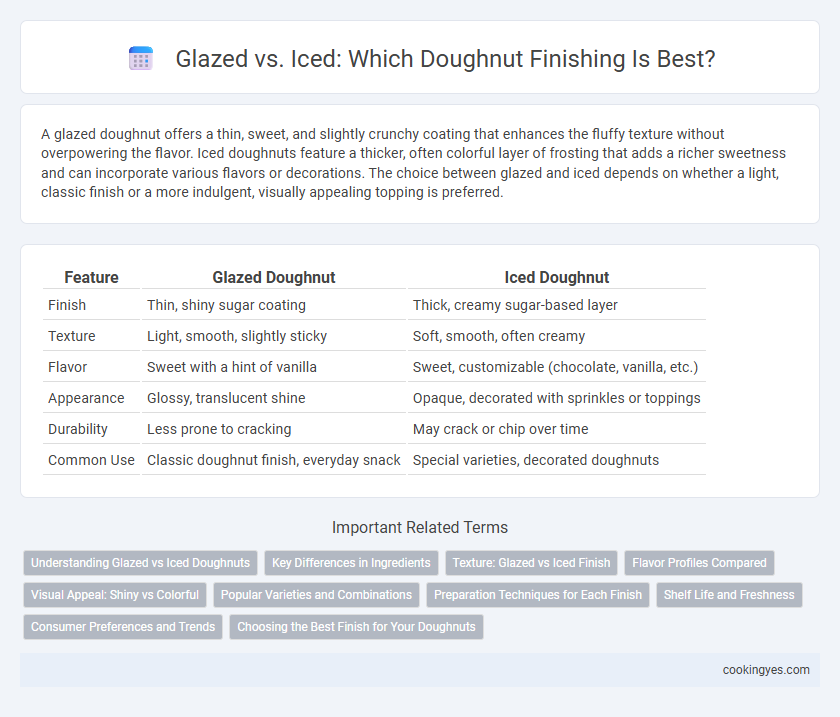A glazed doughnut offers a thin, sweet, and slightly crunchy coating that enhances the fluffy texture without overpowering the flavor. Iced doughnuts feature a thicker, often colorful layer of frosting that adds a richer sweetness and can incorporate various flavors or decorations. The choice between glazed and iced depends on whether a light, classic finish or a more indulgent, visually appealing topping is preferred.
Table of Comparison
| Feature | Glazed Doughnut | Iced Doughnut |
|---|---|---|
| Finish | Thin, shiny sugar coating | Thick, creamy sugar-based layer |
| Texture | Light, smooth, slightly sticky | Soft, smooth, often creamy |
| Flavor | Sweet with a hint of vanilla | Sweet, customizable (chocolate, vanilla, etc.) |
| Appearance | Glossy, translucent shine | Opaque, decorated with sprinkles or toppings |
| Durability | Less prone to cracking | May crack or chip over time |
| Common Use | Classic doughnut finish, everyday snack | Special varieties, decorated doughnuts |
Understanding Glazed vs Iced Doughnuts
Glazed doughnuts feature a thin, transparent sugar coating that hardens to create a shiny, crisp finish, enhancing the doughnut's sweetness without overwhelming its texture. Iced doughnuts are topped with a thicker, colorful layer of frosting made from sugar, water, and flavorings, which provides a softer, creamier texture and allows for a variety of flavors like chocolate, vanilla, or maple. Understanding the difference between glazed and iced doughnuts helps in selecting the desired balance of sweetness, texture, and visual appeal for specific tastes and occasions.
Key Differences in Ingredients
Glazed doughnuts feature a simple mixture of powdered sugar, milk, and vanilla extract, creating a thin, translucent coating that adds a subtle sweetness and shiny finish. Iced doughnuts use a thicker frosting made from powdered sugar combined with more substantial liquids like cream or butter and often include flavorings or food coloring, resulting in a richer, more opaque topping. The primary ingredient difference lies in the glazing's lighter, more liquid consistency versus the icing's thicker, cream-based texture designed for a variety of flavors and decorative finishes.
Texture: Glazed vs Iced Finish
A glazed doughnut features a thin, smooth sugar coating that creates a light, slightly crunchy texture, enhancing the doughnut's softness without overpowering it. An iced doughnut, by contrast, is topped with a thicker layer of flavored frosting that provides a denser, creamier mouthfeel and a more substantial bite. The choice between glazed and iced finishes significantly impacts the overall texture experience, with glaze offering subtle crispness and iced offering richer decadence.
Flavor Profiles Compared
Glazed doughnuts offer a classic, sweet vanilla flavor with a light, sugary coating that enhances the softness of the dough. Iced doughnuts feature a thicker, often flavored icing such as chocolate, maple, or strawberry, providing a richer, more intense taste experience. The contrast between the subtle sweetness of glaze and the bold flavors of icing allows for varied indulgence based on personal preference.
Visual Appeal: Shiny vs Colorful
Glazed doughnuts feature a smooth, shiny finish that catches the light, enhancing their classic appeal and highlighting the golden-brown texture underneath. Iced doughnuts offer a vibrant, colorful topping that adds visual contrast and can be customized with various hues and decorations. The choice between glazed and iced affects not only taste but also the eye-catching presentation that draws consumers.
Popular Varieties and Combinations
Glazed doughnuts feature a thin, sweet sugar coating that adds a shiny finish and subtle sweetness, often paired with classic vanilla or chocolate glazes. Iced doughnuts offer a thicker, more flavorful layer of frosting that can incorporate various flavors like strawberry, maple, or lemon, frequently topped with sprinkles, nuts, or coconut flakes for added texture. Popular combinations include glazed doughnuts with a simple sugar finish for a traditional taste, while iced varieties often appear with bold toppings and fillings such as custard, jam, or cream to enhance flavor complexity.
Preparation Techniques for Each Finish
Glazed doughnuts are prepared by dipping the fried dough immediately into a warm sugar glaze, allowing the coating to set with a thin, shiny finish that soaks slightly into the pastry. Iced doughnuts involve spreading or piping a thicker layer of frosting or icing on the cooled doughnut surface, offering a more opaque and decorative finish that often includes additional toppings like sprinkles or nuts. Both techniques rely on timing and temperature control to achieve the desired texture and appearance, with glazing requiring a hot glaze and immediate dipping, while icing demands a cooled doughnut and a thicker, spreadable consistency.
Shelf Life and Freshness
Glazed doughnuts typically have a shorter shelf life due to the sugar glaze's moisture content, which can cause quicker staleness compared to iced doughnuts. Iced doughnuts often feature a thicker, more stable frosting layer that helps retain freshness by creating a slight barrier against air exposure. Manufacturers find that iced finishes extend shelf life by a day or two, making them a preferred choice for longer-lasting doughnut products.
Consumer Preferences and Trends
Glazed doughnuts, with their classic, transparent sugar coating, remain the top choice for consumers seeking a traditional, sweet but light finish. Iced doughnuts offer a broader range of flavors and colors, appealing to younger demographics who favor visually vibrant and diverse taste experiences. Market trends show a growing preference for innovative icing flavors, such as matcha and salted caramel, driving increased sales in specialty doughnut shops.
Choosing the Best Finish for Your Doughnuts
Glazed doughnuts offer a light, sweet coating that enhances the doughnut's natural flavor with a shiny, smooth texture, making them a classic favorite. Iced doughnuts feature a thicker layer of flavored icing or frosting, providing more variety in taste and color, ideal for creating visually appealing and richly flavored treats. Selecting between glazed and iced finishes depends on whether you prefer a subtle sweetness or a bold, decorative appearance to complement the doughnut's base.
Glazed vs Iced for doughnut finishing Infographic

 cookingyes.com
cookingyes.com